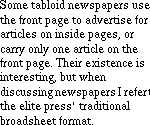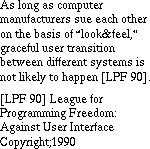2.1 Newspaper Building Blocks
The front page is the most distinct feature of the newspaper format. It was invented 300 years ago [Gürtler 84] , and has changed little since then. Without exception, industry predictions of the future of the newspaper include a front page [DESIGN 88]
, and has changed little since then. Without exception, industry predictions of the future of the newspaper include a front page [DESIGN 88] . The upper part of the front page is covered by the nameplate that carries the newspaper's name. Traditionally, the nameplate is positioned at the top of the page, centered, and often set in an old font type that reflects the dignity of the medium.
. The upper part of the front page is covered by the nameplate that carries the newspaper's name. Traditionally, the nameplate is positioned at the top of the page, centered, and often set in an old font type that reflects the dignity of the medium.
The area below the nameplate is dominated by the headlines of the most important stories. The size of the headline font reflects the relative importance of an article. The article itself is printed under the headline. Since American newspapers put more articles on the front page than there is room for, only the first part of the article is printed. To read the last part, the reader must jump to an inside page.
The size of the headline font reflects the relative importance of an article. The article itself is printed under the headline. Since American newspapers put more articles on the front page than there is room for, only the first part of the article is printed. To read the last part, the reader must jump to an inside page.
The articles are laid out in columns of fixed width. This makes line lengths shorter than e.g. in books, and leading can be reduced since the horizontal retrace is shorter and easier to follow for the human eye. These factors make it possible to put more text on each page. The fixed width of the columns also makes it easier to tile articles of different size and shape.
While the front page contains articles from several categories, inside pages are more specialized. Main categories have their own section, such as "sport" and "business". Within these sections are found additional detail, related topics, and juxtapositions.
Together, the elements of the newspaper form a user-friendly product that is universally accepted and highly functional for its purpose.
The size of a newspaper broadsheet makes it possible to display huge amounts of information. By scanning the front page, the reader can get an overview of the most important issues in a matter of seconds. Large quantities of news can be searched with little or no predetermined focus. The process of scanning helps the user to uncover and read articles of interest, without incurring significant overhead on the part of the reader either in terms of time or effort.
Simply by switching from scanning to reading, the user is able to change modality from overview to detail. The front page is your menu in which the selections are available immediately. If the reader finds that the wrong selection was made, i.e., the wrong article is being read, the menu is still there to choose from.
The newspaper is a static medium for one way communication only. Still, by turning to a section page a reader can drastically change the content of the page being looked at. The stories on the page become more specialized, and in one sense the reader has interacted with the editors of the newspaper. By turning to the section, the reader requests more information, and the editor provides more coverage. Of course, the interaction is predefined and limited to the content of the newspaper edition.
Newspapers provides a facile and forgiving interface by not demanding anything from the reader, and they update themselves without requests. It's a forgiving interface; even if a subscriber ignores the paper for a week, the journalists and editors will still produce new editions.
Journalists write most stories in the "inverted-pyramid style"
Computer interfaces also make use of menus of various kinds where the user chooses a specific element from a list, after which the computer executes the selection. Typographical cues are rarely used to differentiate items. If the computer performs a successful search, the result is displayed on a small screen with few typographical clues. Then, the computer requires the user to issue several commands, like pan or scroll, to show the full result of the retrieval. In comparison with a newspaper front page, the computer menu falls short.
Modern computer programs are event-driven, i.e., nothing will happen unless the user issues commands, e.g., a mouse click or button press. The interface keeps the user active and in control, and if the user is inactive, most computer programs will remain passive. Editions of a newspaper, in comparison, will keep coming without user feedback.
While newspapers are a universally accepted and understood product, computer code requires specific hardware and specific versions of the operating system to run properly.
Generated with CERN WebMaker
2.2 The Newspaper Interface
The basic building blocks of the newspaper turns into an advanced user interface when skilled editors and typographers collaborate on the product. When preparing the newspaper, and especially the front page, editors process the information to accommodate all readers. A reader that only spends a few minutes browsing the news will easily pick out the main stories by skimming the headlines, which summarizes the content. --the main points of the story are described in the first paragraphs, the last ones are written with the editor's scissors in mind, i.e., they may be cut. Therefore, by reading a paragraph or two, the reader will comprehend a disproportionately large part of the news. Minimum effort is required to digest 10% of the print, and there is little penalty in skipping the remaining 90%, but the information is there if the reader has the time and interest.
--the main points of the story are described in the first paragraphs, the last ones are written with the editor's scissors in mind, i.e., they may be cut. Therefore, by reading a paragraph or two, the reader will comprehend a disproportionately large part of the news. Minimum effort is required to digest 10% of the print, and there is little penalty in skipping the remaining 90%, but the information is there if the reader has the time and interest.2.3 The Computer Interface
There are fundamental differences between the newspaper interface and that of the usual computer information retrieval system. Computers offer largely sequential access under direct control of the user. No assumptions are made by such systems as to the user's intent, therefore the presentation of the data is not tightly coupled to its retrieval. The user interface of computer programs varies enormously from system to system. Even programs based on the popular "desktop metaphor" cannot be interchanged freely--neither by computers nor humans.
The user interface of computer programs varies enormously from system to system. Even programs based on the popular "desktop metaphor" cannot be interchanged freely--neither by computers nor humans.
The Electronic Broadsheet - 30 JUN 95
[Next] [Previous] [Top] [Contents]